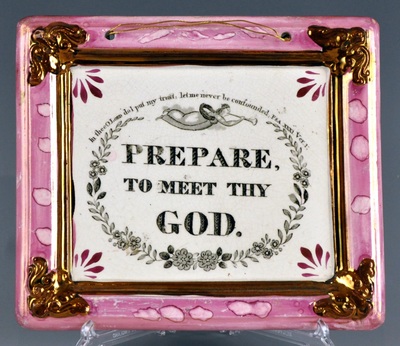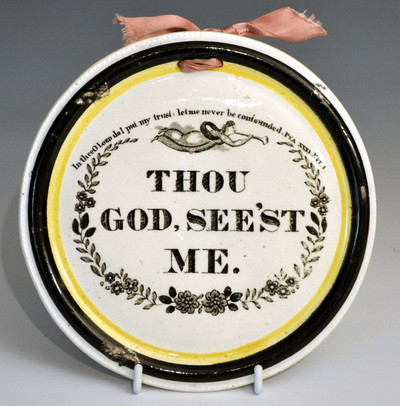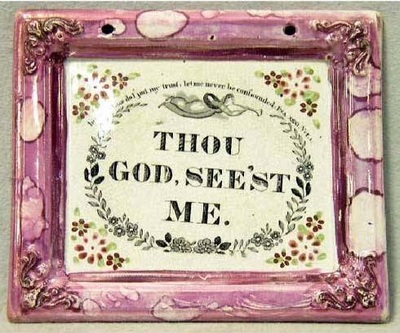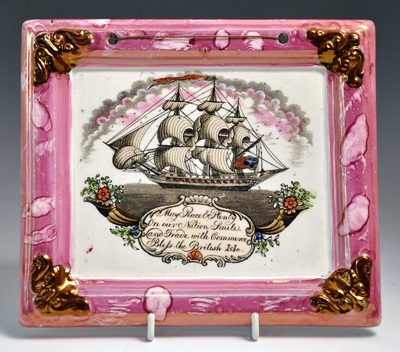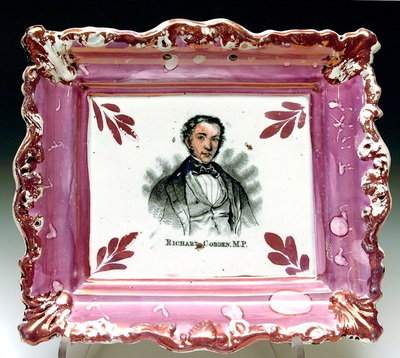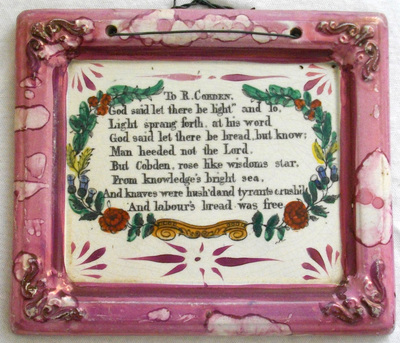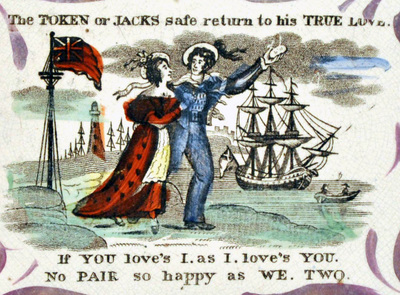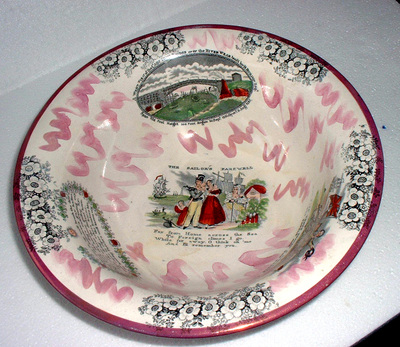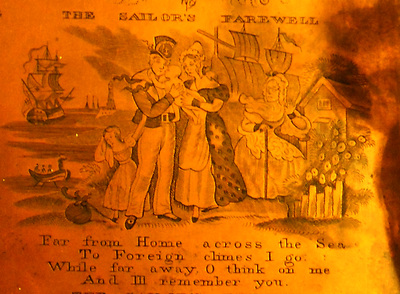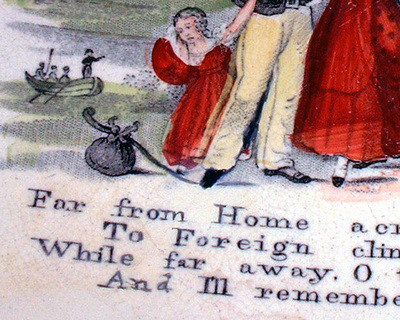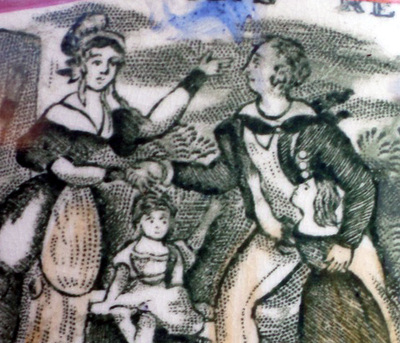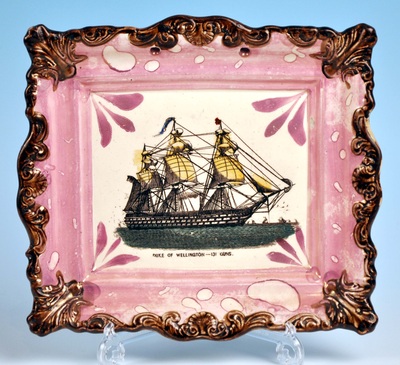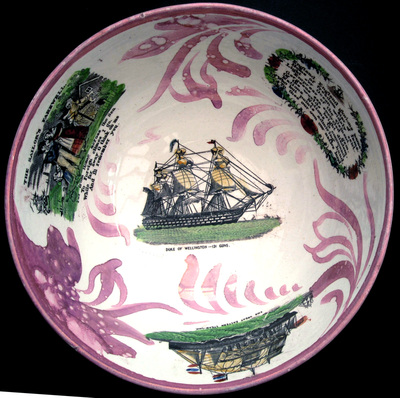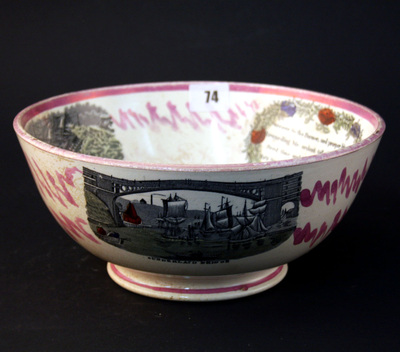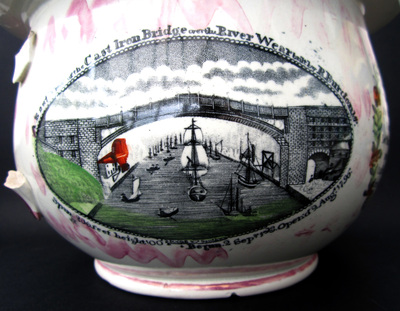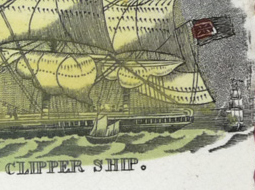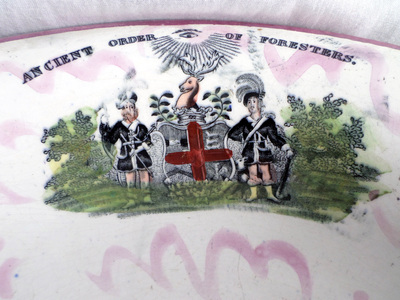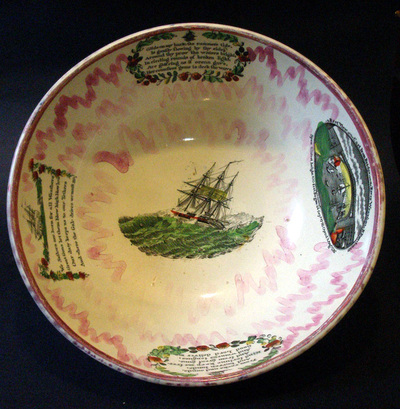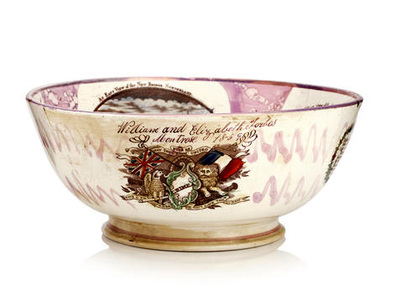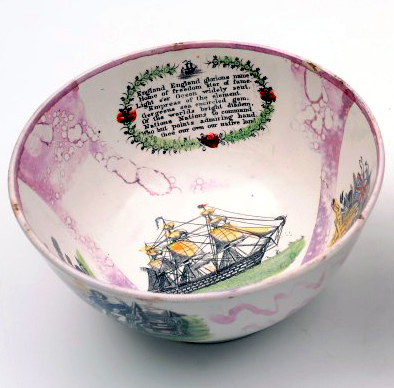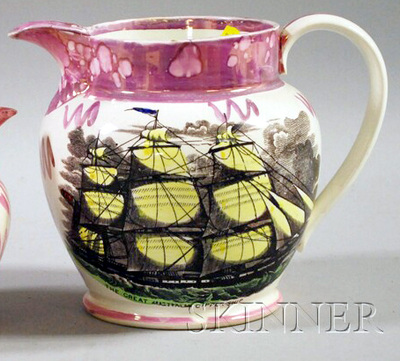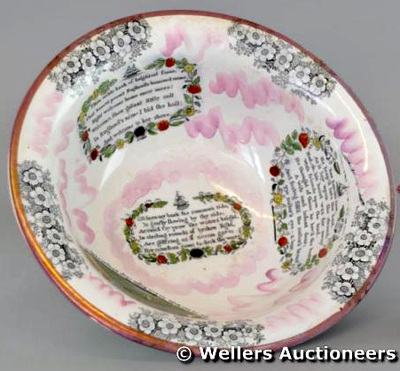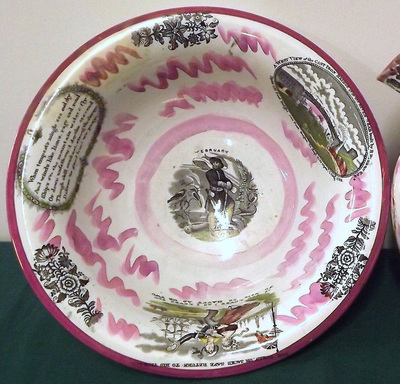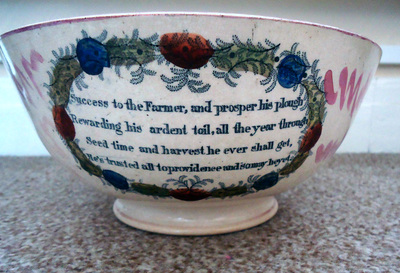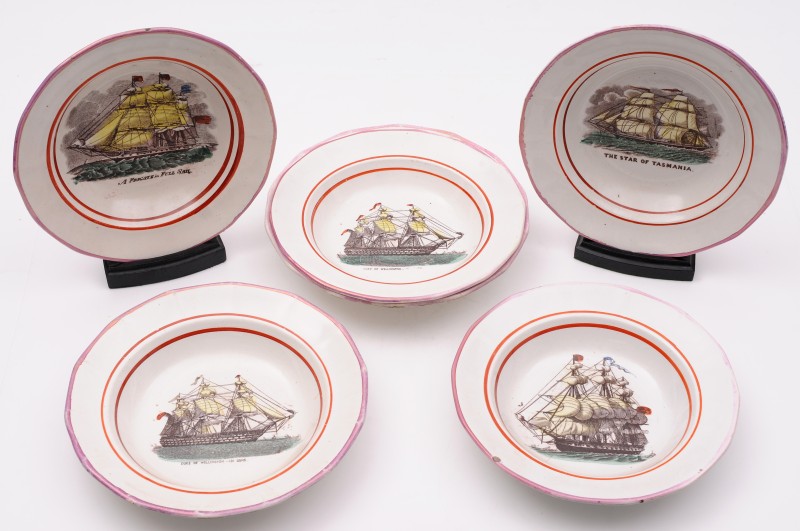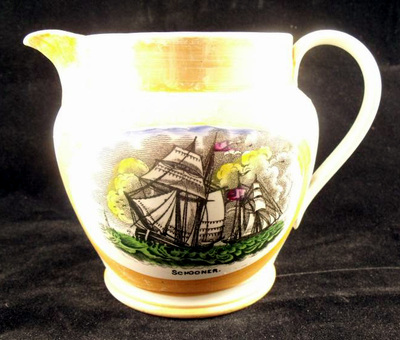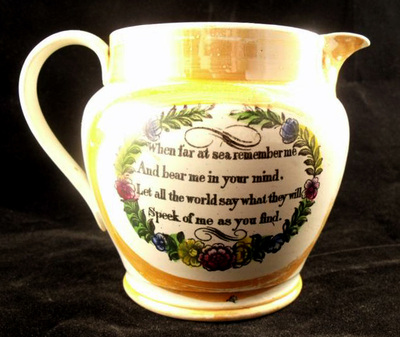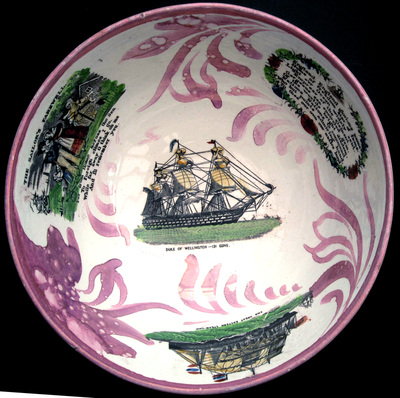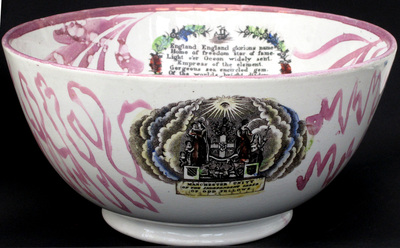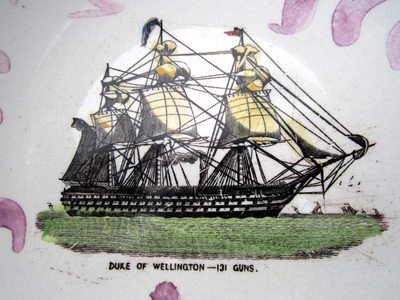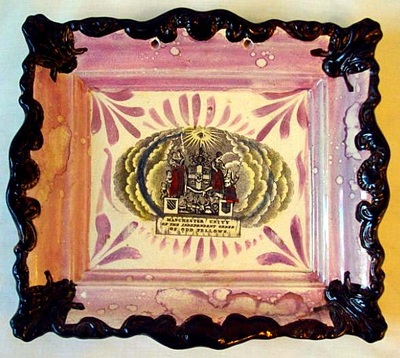|
7/31/2014 0 Comments The group 2 transfersIn my June 14 post, I looked at transfers I'd attributed to Scott's, and divided them into two groups. The group 1 transfers were straightforward enough, because they were traceable back to known Scott wares from the 1830s and 40s. The group 2 transfers' only link with Scott's was that they appeared on the brown-bordered plaques from the 1860s. However, I've since reattributed the brown-bordered plaques to Moore's. So that leaves us with an orphaned group of plaques with group 2 transfers from c1835-1860, the period before they likely arrived at Moore's. To recap, here are the transfers. Firstly the religious verses. The plate 2 Prepare transfer appears on a variety of plaque forms. The first below is attributed to Newbottle, the rest are currently homeless. The plate 3 Prepare transfer also appears to have started life at Newbottle High Pottery, and is found on a similar limited group of plaque forms... Likewise, the plate 3 Thou God transfer... ...and the plate 3 Praise Ye transfer. So if the transfers above started life at Newbottle in the 1830s and ended at Moore's in the 1860s, the strongest contenders to have made the (as yet unattributed) pink-lustre plaques above are Newbottle and Moore's. The argument for Newbottle... The black and yellow Praise Ye plaque was presented to the V&A in 1905 by a descendant of the owners of Newbottle High Pottery, along with a variety of other items. Some have questioned the breadth of objects donated, but archaeological digs of the High Pottery site have since confirmed the provenance of the most contentious items. The fact that Newbottle had two Prepare transfer plates suggests it was making plaques in considerable quantities. The argument against Newbottle... Very little is known about the lustre items Newbottle produced, as they don't appear to have marked anything (all the plaques above are unmarked). The argument for Moore's... Most of the 'group 2' transfers appear on brown-bordered plaques now attributed to Moore's. The argument against Moore's... We have a very clear idea of what Moore's was doing in the 1840-50s, and there's no evidence they used any of the plaque forms above, which never appear with Moore transfers. Conversely, the group 2 transfers don't appear on Moore plaque forms until c1860. Furthermore, there's no evidence of Moore's decorating plaques with hand-painted flowers or green (or blue) corners. And, the Prepare plate 3 above doesn't appear on brown-bordered plaques, so apparently never made it to Moore's. So it's looking like a one-horse race. If it were just the plaques above, we might say why not? And allow the new attribution to pass with little more thought. But attributing the group 2 transfers to Newbottle opens the doors for a an array of other plaques, which, until now, had no links with that pottery. The non-religious group 2 transfers are set out below. The May Peace and Plenty transfer appears on c1845-55 plaques of similar forms to those above, some of those with green or blue corners. The Mariners' Arms and Mariners' Compass transfers also appear on these plaque forms, and another (shown third below), which at first glance looks like a Dixon plaque, but is more heavily potted. A transfer of Richard Cobden appears on the small rectangular group 2 form (first below). It also appears on rectangular plaques, larger than those with brown borders attributed to Moore. It's likely these were made c1846, when the Corn Laws were repealed. A verse dedicated to R. Cobden also appears on the small rectangular plaques, and plaques with blue corners. A verse titled The Farmer sometimes pairs with the R. Cobden verse, and appears on plaques with blue corners and plaques decorated with flowers like those above. And finally, a view of the Cast Iron Bridge Over the River Wear also appears on the group 2 plaque forms. So that makes a hermetic group of 11 transfers and at least 7 plaque moulds, that don't precisely match anything produced by the larger Sunderland potteries - Dixon's, Scott's or Moore's - until c1860 when the transfers appear on the Moore-attributed brown-bordered plaques. All this is consistent with the transfer plates and moulds being at a self-contained location - a smaller pottery producing lustre items. And we have a credible Newbottle provenance, for the religious plaques at least.
More research needs to be done, but the only realistic attribution for these plaques, with the information currently available, is Newbottle High Pottery.
0 Comments
 Huge thanks to Shauna Gregg at the Sunderland Museum for sending images of this copper transfer plate in the museum collection. Here's what Baker says about it... 'A copper plate was presented to Sunderland Museum by a member of the Ball family in 1963. [The transfers] are engraved on a copper plate manufactured by Pontifex and Stiles, 23 Lisle Street, London. In 1834, William Stiles joined Russell Pontifex, up to then trading as R. Pontifex and Son. The name was changed to Pontifex and Stiles until the partnership ended in 1839. As one of the designs on the plate has the name 'Dixon, Phillips & Co, one must assume that the firm changed its name some time between 1834–39. This copper plate appears to have passed through the hands of either Moore's or Scott's (possibly both) and finally to Ball Brothers.' From press announcements we now know that the Dixon, Phillips & Co partnership began in 1839. So if the copper plate was engraved by Pontifex and Stiles for that partnership, it could only have been made in that year. And if it did start life at the Garrison Pottery (Dixon's), it likely would have found its way to Moore's and/or Scott's after 1865, when the Garrison Pottery closed. But there are a couple of 'ifs' in this paragraph. The TokenSo was the above transfer plate used by Scott's or Moore's, or both? Below left is a bowl attributed to Scott with similar transfers, and below right, a brown-bordered plaque attributed to Moore. If you look at the details of the transfers, it's clear that the plaque (right details) has a transfer from a different copper plate. The bowl, however, has a very similar transfer to the copper plate above (see left and centre details). The Sailor's FarewellThe differences between the Sailor's Farewell transfers are even more pronounced (Scott-impressed bowl below left, Moore-attributed plaque below right). The sailor is wearing a completely different hat (bowl centre, plaque right). There's a crucifix-shaped mast behind the woman's head in the Scott version, which again is very similar to the copper plate (left). However, for all the close similarities, I think the Scott version also comes from a different transfer plate. Compare the two details below. The shadows under the man's feet, the raised oar in the rowing boat in the Scott version. And yet, the spacing of the lettering is identical. At first I thought this might be down to the image having been re-engraved. But more likely, the image of one of the copper plates was transfer printed onto copper, which was then engraved to form a copy/second plate. The Sailor's ReturnSo if the copper plate corresponds neither with transfers used by Scott's nor Moore's, where was it used? Ian Holmes has a bowl on his United Collections website that certainly comes from this transfer plate. Below is a comparison of the Sailor's Return transfer on the Scott attributed bowl (left) and Ian's bowl (right) attributed to Ball's Deptford pottery. If you move between the images, you'll see the Ball's bowl is the perfect match. One blindingly obvious difference between the transfers is the printed mark 'Dixon Phillips & Co Sunderland' which appears on the Ball's bowl and on the copper plate. If the Scott version (top detail below) were copied from an 1839 Dixon's copper plate, Scott's might well have chosen to omit the printed mark. But, as Ian Holmes points out, the mark appears to have been added as an afterthought, squeezed into a narrow gap, with bits of shading running through it, and in decidedly spidery script. The Flag that's Braved a Thousand YearsThe last of the pictorial transfers on the copper plate also has the 'Dixon Phillips & Co Sunderland' mark. In this case we're comparing the transfer on a Scott-impressed bowl (left), with the Ball's-attributed bowl (right). There are many subtle differences with the Scott transfer (below left), but in particular note the top of the crutch of the sailor on the right. This is more than just later re-engraving. The Scott transfer almost certainly comes from a different copper plate. And again notice how the Dixon mark has been squeezed into a gap (Scott version top). It again runs over the shaded areas, suggesting that it was added at a later date. The transfer plate above may have originated at Dixon's - we'd need to know more about why Baker was so sure it was engraved by Pontifex and Stiles. Is there a mark on the copper plate somewhere? - I couldn't find one. Even if that were proven, it wouldn't necessarily follow that the 'Dixon Phillips & Co Sunderland' mark was genuine. Ball's has an already murky reputation as a pottery that printed items with other potteries' marks. But forging a mark would take them into a whole new league. Could the Ball's family inadvertently have donated evidence of forgery to the Sunderland Museum? We may never know, but we owe them a huge debt of gratitude for saving the copper plate. One thing that might settle it would be to find an 1840s or 1850s Dixon item with the Ball's transfers. However, in many hours of searching over recent weeks, I haven't found anything from Dixon's with these transfers. Some last thoughtsMoore's, Scott's and Ball's appear to have used different versions of the transfers that appear on the copper plate in this post (I could have done a similar exercise with the verses, but you would have lost the will to live). It would have been tidier if the Scott transfers matched those on the copper plate, and if the Dixon attribution of the plate had been stronger. That way, we could have fairly confidently dated the Scott items to post-1865 when the Garrison Pottery closed.
But with regards to my thoughts of recent weeks, nothing much has changed. We already knew that the Scott versions of these transfers were likely used in the 1860s, because of similar plaques with dates in the Sunderland Museum (see below). And yes, that's the period when the brown-bordered plaques were produced. The 'Scott' versions of these transfers never appear on Moore's items. However, the 'Moore' versions of the transfers do appear on Scott's items, likely because Scott's sent them to Moore's for decoration. I've spent weeks (years) thinking about the transfers shared by Scott and Moore in the 1860s. The brown-bordered plaques (left below), made during that period, are probably most associated with the series of common ship transfers. Those transfers rarely appear on items with the Moore impress, and yet frequently appear on bowls with Scott impressed marks (right below) and on the jugs that pair with them. For this reason, the brown-bordered plaques, which are never marked, are almost universally attributed to Scott. I'm now as certain as I can be that's wrong, and have set out the reasons below. 1. Moore's made marked items with the ship transfers in the 1850sThe two plaques below, which pre-date the brown-bordered plaques, both have 'Moore & Co' impressed marks. As does the bowl from Bonhams, with ship transfers and the date inscription, 1859. This evidence alone would be enough to make the case, were the attribution of the brown-bordered plaques to Scott not so widely held. The Moore-impressed items are relatively rare, which is why I believe they've been overlooked. 2. Moore's made similar looking plaques in the 1850sAlthough there's no evidence of Moore's using the larger rectangular mould of the brown-bordered plaques during the 1850s, they made smaller plaques with almost identical lustre decoration. Compare the corner of the Bottle plaque (top centre) which has a Moore printed mark, with that of a plaque with brown borders (top right). Also, compare the decoration on the 1850s' Moore plaque (bottom left), with that of the brown-bordered plaque with the same transfer. 3. There are very few plaques attributable to Scott from the 1850sThe only plaque forms firmly attributable to Scott's are those with group 1 transfers (see three examples below). The first two were likely made in the 1830s or 40s. We know from examples of the last plaque form with hand-painted dates that they were made from c1858 onwards. Scott's doesn't appear to have made plaques during the early- to mid-1850s (unless they continued to make the earlier plaque forms for longer than imagined). So it seems fair to say that Scott's had a very limited stake in making plaques. And the plaques it did produce look nothing like the brown-bordered plaques. 4. There are very few bowls marked Moore from the 1860sMoore's made a fair number of bowls during the 1840s and 50s (see below), but appears to have stopped making them in the early 1860s. This proves nothing in itself, but might hint at a division of labour during this transfer-sharing period, with Scott's making bowls and jugs, and sending them to Moore's for decoration. With Moore's, meanwhile, focussing their efforts on making plaques, as they'd done so prolifically during the 1840s and 50s. 5. The majority of transfers on brown-bordered plaques originated at Moore'sAs discussed in my June 29 post, the majority of the transfers that appear on the brown-bordered plaques, which are traceable to earlier wares, originated at Moore's. There's no obvious reason to believe that Moore's would cede such a large number of transfer plates to neighbouring Scott's. Isn't it more likely that Moore's continued to decorate items with its own transfers? The simplest answer is always the best. 6. Scott's transfers don't appear on brown-bordered plaquesIf Scott's made the brown-bordered plaques, why didn't they decorate them with their own transfers? The Scott group 1 transfers never appear on brown-bordered plaques. Not even the Prepare to Meet Thy God (plate 1) that was used well into the 1870s. The Scott versions of the Sailor's Return and Farewell and associated transfers (see left below) and the Scott months (see right below) never appear in conjunction with the common ship transfers, nor on the brown-bordered plaques. And yet, Scott was widely using these transfers at the time the brown-bordered plaques were produced. The only good reason for these two groups of transfers remaining so completely discrete, is that the copper plates were held at different locations. 7. The lustre decoration on jugs and bowls with ships matches Moore itemsLustre decoration is more difficult to pin down, and it seems likely that both potteries had several people (women? children?) decorating items with lustre. But each pottery had a different house style. Moore's decoration tends to be in long unbroken lines of zig-zag markings (see below left), whereas Scott's tends to be more fluid and curvy, with marks in shorter bursts (see below centre). The Scott items with ships (below right) tend to have 'Moore' decoration. 8. The ship transfers never appear with Scott's flowersAlthough both Scott's and Moore's decorated jugs, mugs and bowls with flowers in the 1840s and 50s, only Scott's continued into the 1860s. Scott's flowers from that period (see left and centre below) never appear in conjunction with the ship transfers, whereas they commonly appear with the Scott group 1 transfers. Scott's made large numbers of jugs and bowls during this period, and decorated some themselves with their own (group 1) transfers and flowers. They appear to have sent others to Moore's for decoration with ships (below right), and those items never appear with Scott flowers. 9. Moore's was a bigger pottery than Scott'sDuring the 1860s Moore's went through a period of modernisation and expansion. A manager called Ralph Seddon from Staffordshire was appointed, and 'on his advice the works were largely rebuilt and equipped with modern machinery'. Between 1866 and 1872 the pottery was reported to be the largest on Wearside. Operating at full capacity, Moore's could have employed up to 250 hands, although was reported to have 180 during this period, whereas Scott's employed about 150 (Baker). If we put aside the decoration of plaques, jugs and bowls with ship transfers, we still have a clear idea of what Scott's was doing in the 1860s. They potted a large number of jugs, ewers, and bowls, and they decorated many of them with their own (group 1) transfers, often with typical flower decoration. They made their own particular rectangular plaque form, and decorated those plaques with the group 1 transfers. But what else was Moore's, the larger pottery, doing during that period? If you subtract the brown-bordered plaques, and decorating items for Scott's, very little remains by way of lustre items. However, according to Baker, it wasn't until 1875 that Moore's 'concentrated chiefly on making dinner sets of various patterns, abandoning what it considered the old-fashioned transfer-printed pink lustreware'. Moore's had the capacity to make the brown-bordered plaques, and to take in pottery from other factories for decoration. Aside from doing that, it's unclear what else the pottery was producing, by way of lustreware, during this period of technological improvement and expansion. 10. Records show that Scott's sent items to Moore's for decorationBaker writes that 'the transfers used by Scott's were frequently the same as those used by the nearby Wear (Moore's) Pottery. Moreover, according to the firm's records Scott's supplied earthenware to Moore's Wear Pottery [...] presumably plain for decoration.' The group of transfers that Baker is referring to are those that appear on brown-bordered plaques. There's no evidence of sharing of Moore's or Scott's transfers from the 1840s. And there's no evidence of Scott's sharing its group 1 transfers, until c1870, and the orange lustre period. I'm still waiting for a response from the Sunderland Museum regarding the records Baker referred to. However, regardless of the date of the records (if they are indeed dated), I believe, for all of the reasons above, that there's compelling evidence that Scott's sent items to Moore's for lustre decoration in the 1860s. Having finally come out of the closet with a Moore attribution for the brown-bordered plaques, I have hours of work to do correcting the information on this site. And in case you thought it was all neatly sewn up, there's still the issue of the group 2 plaques in my June 14 post. Did those transfers originate at Scott's, Moore's, Dixon's or Newbottle High Pottery, or another Sunderland Pottery not yet considered?
Thanks to anyone who has read this far. If you have evidence against my reasoning above, I still am, and always will be, happy to consider it. 7/13/2014 0 Comments Odds and endsGeneral Joseph GaribaldiThanks to Elinor Penna for providing the right image below of a brown-bordered plaque titled 'General Joseph Garibaldi'. Although the green used is different - there are at least three variants of green enamel that appear on these plaques - it is otherwise decorated very similarly to Norman Lowe's Scott-impressed bowl (left below). Although the bowl is marked Scott, you can see in this photo the typical zig-zag decoration, like a letter M, used by Moore. Garibaldi visited London in 1864 and it's possible that these items were made to cash in on this visit. This transfer, however, also appears on earlier Moore plaques, and might have originated at the time of Garibaldi's stay in Tyneside in 1854. Joseph is, of course, the anglicised form of Giuseppe. Moore and Scott flowersThanks to Norman Lowe for the photos of the chamber pot below (first three images) from the 1850s. It has a bridge transfer with the small inscription, 'Moore & Co Southwick', underneath (see top centre detail). It also has flower decoration (what better place to have posies of flowers than around the rim of a po?). As discussed already, flower decoration is more commonly associated with Scott's. Look at the jug below, with a similar bridge transfer, but with a hard-to-read Scott inscription. At first glance the flowers on the items look very similar. So could the two potteries have shared the same copper plates with flower transfers? I still believe the answer to be an emphatic, 'No'. Look at the details below: the left from the Moore chamber pot, the right from the Scott jug. Although one set of flowers is clearly copied from the other, they come from different transfer plates. Moore's appears to have stopped decorating items with flowers sometime in the 1850s, whereas, as discussed in previous posts, Scott's continued into the 1860s. It isn't beyond the realms of possibility that one day a jug or bowl will appear with the common ship transfers and flower decoration. However, I'd expect the flowers to be Moore's. Dixon transfers acquired by ScottThanks to Ian Holmes for the photo of the Scott-impressed bowl below, which has the whole gamut of Dixon transfers: The Gauntlet Clipper Ship, The Agamemnon in a Storm, Garibaldi, and the Dixon Crimea transfer. You can see all the transfers on Ian's United Collections website, along with several other impressed bowls, which all sit nicely with the narrative of my previous post. I've struggled to reconcile some of the transfers on this bowl with the Dixon versions (see the circular plaque below). However, the Dixon bowl (centre below) shows how degraded the transfer had become by the 1860s. The image of Garibaldi on the Scott bowl (right below) might have been so extensively re-engraved that it looks like a different transfer. The engraver, perhaps having no clear imprint to work from, simplified the folds in the collar and re-hatched the body of the coat. There's still room for doubt though, and the Scott version might simply be from a different copper plate. It's difficult to read some of the other transfers on the Scott bowl because the transfers are applied to a curved surface, and chunks are missing. The Gauntlet is titled 'CLPER SHP' instead of 'CLIPPER SHIP' (see right below). But I'm more confident that it is the same transfer that appears on Dixon plaques from the 1850s and 60s (left below) and Scott plaques from the 1860s and 70s (centre below). One transfer on Ian's Scott bowl is nothing like its Dixon counterpart (left below) - Ancient Order of Foresters. The transfers on the Scott-attributed plaque (centre below) and Ian's Scott bowl (right below) are clearly from the same transfer plate. But they are so different to the Dixon version that it's certainly more than a case of re-engraving. Perhaps the transfer was so worn that Scott's commissioned a new one. Perhaps the transfer wasn't on the same copper plate as The Gauntlet, and was simply one of Scott's own mixed and matched on the bowl. We may never know. Theories have to be tested, retested and retested again. Although the picture is far from being straightforward, I haven't yet found anything that's shaken my belief that the plaques, jugs and bowls from the 1860s with common ship transfers were decorated at Moore's. In fact, the more items I look at, the more sure I've become.
7/6/2014 0 Comments Moore and Scott bowls and jugsBowls are a boon for, and the bane of, collectors. They're irresistible because they contain a whole library of different transfers (7 on one item is not uncommon). They help us understand which transfers likely appeared side-by-side on copper transfer plates, and they often have impressed marks. But they're also a pain. Large, unwieldy, and difficult to display. They also tend to be worn through use. I suspect that every serious collector of lustre has a stack of bowls gathering dust in the corner somewhere. Jugs are less of a problem, although they rapidly suck up your living space, and become receptacles for household fluff. Moore and Scott bowls and jugs often have similar lustre decoration. Impressed marks, usually on bowls, tell us with certainty where the items were potted, but not where they were decorated. From the 1860s, there appears to have been some division of labour, with Scott's, supplying Moore's with plain earthenware for decoration. Moore bowlsMoore's made many bowls with transfers from the 1840s and 50s - hunting scenes, ships, and other transfers like Waverley - which never appear on Scott's items. However, bowls with the common ship transfers from the 1850s are rare, which is why I've made such a fuss about the one sold at Bonhams recently with the date inscription 1859 (last bowl below). It is on the money for that date, with transfers of the Star of Tasmania (launched in 1856) and the New Bridge over the River Wear (opened 1859). But other than this item, I've had difficulty finding any Moore bowls or jugs from around the early 1860s. Decoration on these Moore items is typified by zig-zag rows of pink lustre, something like an ECG (electrocardiogram) trace during ventricular tachycardia. Ian Sharp has compared the zig zags to the letter 'M' for Moore. Scott's also used wave-like decoration, but the waves tend to be smoother, shorter, and more curvy. However, the first bowl below shows that Moore's also used curvy waves. So trying to identify wares based on lustre decoration is an imprecise science. Scott bowls and jugs with ship transfersThe three bowls below are all impressed 'Scott'. As discussed in my previous post, these items are decorated with identical enamels to the brown-bordered plaques. The lustre decoration on the side of the first bowl (right side of second image) has a more than fleeting similarity to the Moore zig zags. On the last bowl below, the way the lustre is painted around the transfers in thick swathes is similar the Moore-impressed bowl from Bonhams, above. The similarities of decoration with early Moore wares are more pronounced on jugs with ship transfers. Unlike the bowls, the jugs are rarely marked, but the first ewer below is a typical Scott form (more on that below). The waves on the jugs below are pronouncedly zig zags and not curves. Again, the enamelling over the transfers is identical to that on the brown-bordered plaques. Another thing to note is the thick band of lustre around the rim of each item. And look at the two bowls below. The bowl on the left has the Moore & Co impress. The bowl on the right, with very similar decoration, is impressed Scott. These items, however, might post-date the brown bordered plaques. The Moore bowl has an impressed letter under the 'Moore & Co' mark, in common with later Moore items (see another example at the end of this post). The transfers on the Scott bowl, and the last two jugs above, appear frequently on orange lustre items. Scott bowls and jugs with 'group 1' transfersThese are the items which we can whole-heartedly attribute to Scott. They have transfers that never appear on brown-bordered plaques. The plaque forms they appear on are also found with the religious transfers that Scott used in the 1830s and 40s. The decoration is 100% Scott's. The lustre decoration is fluid and curvy. There are transfers of flowers, particular to Scott during this period, around the rim. The six bowls below are all impressed Scott. Another unique Scott feature is the use of a series of transfers showing the months of the year. These often appear in the centre of the bowl, as in the last example above, and sometimes on the side like the two bowls below. I'm not yet aware of them ever being recorded on bowls with ship transfers. The decoration of jugs that pair with these items (again these all seem to be unmarked) is very different to that of jugs with ships. There is no wide band of lustre around the rim. Rather, the rims are decorated with three fine bands of lustre and/or with flower transfers. Note the ewer below (bottom left). It appears to come from the same mould as the one with the ship transfer above, but has very different decoration. What better explanation than Scott's potted the ewers, decorated some themselves, but sent others off to Moore's, plain for decoration? Later Moore pink-lustre jugs and bowlsSometime around the late 1860s or early 1870s, Moore's began to produce jugs and bowls with the Scott group 1 transfers. Interestingly, the lower left bowl has the Agamemnon in a Storm transfer that originated at the Garrison Pottery, so is certainly post 1865. The decoration on these items is distinctively Moore's, and both the bowls below have impressed marks. So either the transfer plates moved from Scott's to Moore's, or, more likely to my mind, both potteries concentrated their decoration activities at a third location, Sheepfolds Warehouse, and shared transfer plates. Clearly there's a risk of getting carried away, making a limited group of items fit the narrative you want them to fit, particularly where lustre decoration is concerned. The people who decorated pots with lustre, using their own unique signature strokes, could have moved from one pottery to another, just as the copper transfer plates did.
But... and it's a huge but ...we know what Scott-decorated jugs and bowls looked like in the 1860s, and they look very different from those decorated with ship transfers. The items with ship transfers, even if they're impressed Scott, have more in common with Moore bowls from the 1850s. I think the confusion about attribution of the brown-bordered plaques has arisen because there are so many Scott-marked bowls with the ship transfers. Whereas, Moore appears to have made very few bowls and jugs during the 1860s. Perhaps decorating Scott jugs and bowls was enough, and Moore's focussed their energies on making plaques. Or perhaps Scott's made the plaques too, and all Moore's did during this period was decorate. But whoever did the potting, Moore seems to have more right of ownership of the brown-bordered plaques than Scott. Aside from the obvious answer - because everybody says so - here are some reasons why I have thought the brown-bordered plaques originated at Scott's. Reason 1Because there's a photo of a Scott-impressed bowl with the 'Great Eastern' transfer in Baker. Baker's book, 'Sunderland Pottery', is the best and most reliable source of information on the subject. His chapter on 'Southwick or Scott's Pottery' has only a handful of photos of Scott transfer-printed lustre items. The Great Eastern, as the first example shown, has star billing. However, Baker takes pains in the text to point out that 'the transfers used by Scott's were frequently the same as those used by the nearby Wear (Moore's) Pottery. Moreover, according to the firm's records Scott's supplied earthenware to Moore's Wear Pottery [...] presumably plain for decoration.' Nowhere does Baker suggest that Scott made the brown-bordered plaques. Reason 2More ship transfers appear on soup bowls with the Scott impress, than appear on Moore-impressed plaques. I've seen plaques with The Duke of Wellington and La Bretagne transfers with the Moore impress, but on the soup bowls Scott takes ownership of the set, marking them 'Scott' over an impressed letter. However, we know the ship transfers originated at Moore's. The 'Prepare' soup bowl below, with an indistinct Scott impress, has the Moore plate 4 transfer. So the argument that the soup bowls are marked 'Scott', therefore Scott's made the brown-bordered plaques, doesn't necessarily follow. I'd assumed the soup bowls to be late (post 1870), but, perhaps tellingly, I haven't yet seen them with the later ship transfers: The Unfortunate London, Great Australia, Brig, Schooner or Truelove from Hull. So it's possible that the bowls above pre-date 1865 and were made at the same time as the brown-bordered plaques. However, soup bowls also appear with the shrill enamels of the orange-lustre period (see below). Isn't it possible that Scott's marked the soup bowls so diligently because they were sending them to another pottery, whether Moore's or Sheepfolds Warehouse, for decoration? Reason 3The two transfers below showed traces of flowers on the right hand side, from another transfer on the same copper plate. Scott items were often decorated with flowers around transfers (see below), so I leapt upon that to strengthen the Scott attribution. (Moore also decorated items with flowers in the 1840s, but they are different to those below.) But I was wrong. Look at the jug below, which pairs the Schooner transfer with the verse 'When far at sea remember me'. The two transfers were side by side on the copper transfer plate, and very close together. When cutting up the printed-tissue sheet of transfers the decorator snipped off a bit of leaf and petal. Incidentally, the jug above is attributed to Scott, but from the orange-lustre period of transfer sharing. To my knowledge, and crucially, none of the transfers that appears on brown-bordered plaques appears on Scott items with typical flower decoration around the rim. Reason 4There are Scott-impressed items with the same transfers as the brown-bordered plaques and identical decoration. Thanks to Norman Lowe for providing images of the Scott-impressed bowl below. Comparing the enamel and lustre decoration on the bowl below (left images) with the plaques (right images), I don't think there could be any doubt that they were made at the same time, and decorated at the same location. Look at the flags on the Great Eastern, and the identical enamelling on the Sailor's Farewell. So that settles it; Scott must have made the brown-bordered plaques. Really? I don't think so. Now compare a transfer on the bowl (below left) with a Scott group 1 plaque (below right). As always, click to enlarge and move between the images. The verse on the plaque, although the same, clearly comes from a different transfer plate. The enamel decoration on the plaque is done with a lighter touch. And yes, the Scott group 1 transfers also appear on bowls with Scott-impressed marks from the 1860s. N.B. the transfers on these items appear to have come from the Garrison Pottery in 1865, and are, I think, the ones on the transfer plate donated to the Ball family to the Sunderland Museum. So above are three bowls with the Scott impress, apparently made around the same time. And yet, the first bowl is decorated in a completely different way to the other two. It has transfers from different copper plates, no typical Scott flower decoration, and the enamels are more heavily applied. What better explanation than it, and the brown-bordered plaques, were decorated at another location: Moore's?
Reattributing all the brown-bordered plaques on this site, and relabelling all my files, will be a major undertaking. That's why I've laboured over this so intensively. If anyone has information or items which might throw some light on a Scott attribution for the brown-bordered plaques, I promise to give it my closest attention! |
AuthorStephen Smith lives in London, and is always happy to hear from other collectors. If you have an interesting collection of plaques, and are based in the UK, he will photograph them for you. Free advice given regarding selling and dispersal of a collection, or to those wishing to start one. Just get in touch... Archives
February 2022
AcknowledgementsThis website is indebted to collectors, dealers and enthusiasts who have shared their knowledge or photos. In particular: Ian Holmes, Stephen Duckworth, Dick Henrywood, Norman Lowe, Keith Lovell, Donald H Ryan, Harold Crowder, Jack and Joyce Cockerill, Myrna Schkolne, Elinor Penna, Ian Sharp, Shauna Gregg at the Sunderland Museum, Keith Bell, Martyn Edgell, and Liz Denton.
|


